Fossil fuels: what you didn't know
#Fossil fuels
Before I begin, I want to earnestly apologize to the keepers (curators) of #steemstem for my last post which apparently was written falsification (plagiarism), I am truly sad, I have learnt a considerable measure and I guarantee to be my very own greater amount essayist than outer connections. I truly acknowledge @steemcleaners for hailing(flagging) me and taking me back to my faculties, I am to blame and I let it be known, am sad for baffling @curie and @steemstem who gave me the most elevated upvote of my life and I guarantee to be of good character starting now and into the foreseeable future, so help me God.Am sorry for my last written falsification post
Thank you and I hope you forgive me @curie @steemstem and @steemcleaners
some content of this post where taken from here content source
but 80% of the post is my research
##Fossil fuel
Fossil fuels resources are a vital source of energy for generating electricity, heating homes and for transportation consisting mostly of carbon along with some hydrogen and oxygen. These resources are derived from living organism and are also referred to as hydrocarbon fuels. These includes coal, petroleum, oil shale and tar sand
Petrologists decide the birthplace and normal history of rocks by investigating mineral structure and grain connections.
Geochemists use physical and inorganic chemistry to investigate the nature and distribution of major and trace elements in ground water and earth materials, they use organic chemistry to study the composition of fossil fuel (coal, oil, gas) deposits.
Word : Fossil Fuels (Dictionary)
Definition :
Substances consisting largely of hydrocarbons, derived from decay of organic materials under geological conditions of high pressure and temperature (metamorphism) include coal, petroleum, natural gas, peat and oil shale.
##coal
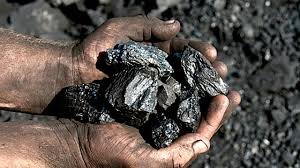
Along with oil and natural gas, coal is the third major energy resource. It provided 90% of the energy used in the U.S.A but provides only 24% today. Coal use is now increasing as petroleum becomes scarce and more expensive, it now provides more energy than natural gas
coal (dictionary)
noun (plural coal or coals)
(uncountable) A black rock formed from prehistoric plant remains, composed largely of carbon and burned as a fuel.
###Geology of coal
coal is a sedimentary rock that forms from the compaction of plant material that has not completely decay. Land plants which decay in the pressure of oxygen decompose to give carbon dioxide and water. In the temperate and tropical climate area partial decay of the abundant plant material uses up and the remaining organic matter is preserved. As the sedimentary over burden increase the organic material is subject to increase heat and pressure that caused the the organic material to undergo a number of transitional state to cool. The increase in temperature and pressure caused the organic material rich in carbon hydrogen and oxygen to become increasingly carbon rich and hydrogen and oxygen poor.
Tar sands
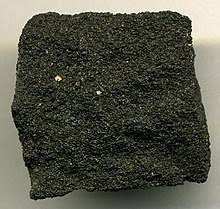
Tar sands are sandstones impregnated with heavy, viscous crude oil which will not run wells. instead the tar is extracted from open-cast mines then it is heated to remove the bitumen. The bitumen is then broken into synthetic crude oil and coke by heating it to about 48°c. Bitumen is a very viscous hydrocarbon material in which the lighter volatile component have been lost.
formation of Tar sand
Tar sand are formed where petroleum migrate upward into deposit of sand or consolidated sandstone. when the petroleum is exposed to water and bacteria present in the sandstone, the hydrocarbons often degrade over time into heavier, asphalt like bitumen
oil shale
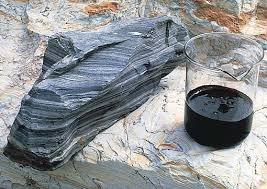
This is a time grained sedimentary rock, That is similar in composition to limestone or shale , contains up to 25% solid organic material that produces oil when heated to about 500°c (900°F) . The waxy organic material contained in oil shale is called kerogen and the liquid oil produced from heating kerogen is known as shale oil .
Origin of oil shale
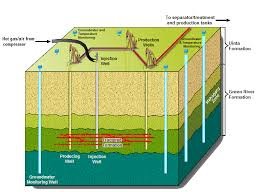
oil shales formed on lake and ocean bottoms after algae, spores and other microorganisms died million years ago and accumulated in mud and silt.
As layers if organic-rich sediment slowly accumulated,the increasing weight of overlying sediments transformed the organic material into kerogen and drove most of the moisture from the slit compacting the material into oil shale how ever the pressure and heat from the build up overlying sediments was insufficient to break down the kerogen chemically into petroleum.
Because oil shale is formed from mid and silt, these sedimentary rocks are extremely fine-grained. Oil shale has low porosity and low permeability. Oil shale depending on kerogen content, the rocks range in colours from light Gray to black. High concentration of kerogen can make oil shale resilient and difficult to crush.
read more on oil shale here oil shale
###petroleum
Word : petroleum
Definition :
Petroleum or crude oil is any naturally-occurring flammable mixture of hydrocarbons found in geologic formations, such as rock strata. Most petroleum is a fossil fuel, formed from the action of intense pressure and heat on buried dead zooplankton and algae. Technically, the term petroleum only refers to crude oil, but sometimes it is applied to describe any solid, liquid or gaseous hydrocarbons.
petroleum originated from organic matter in marine sediments, microscopic organisms, such as diatoms and other single celled algae, settled to the sea floor and accumulated in marine mud. The most likely environment of this are Continental shelves and the continental rise. The organic matter may particularly decompose using up the dissolve oxygen in the sediment. As soon as the oxygen is used up decay stops and the remaining organic matter is preserved to form an organic mud called "sapropel". Continued sedimentation buries the sapropel and and subjects it to higher temperatures and pressure to form black shale, the shale is compressed and heated and petroleum is produced.
This process of converting organic matter into oil and gas is called maturation. Shallow burial produces heavy crude oils while deep burial produces light crude, because the long chain hydrocarbon molecules are broken into smaller molecules by the increase in temperature and pressure. A rock which petroleum forms is called a source rock. Compaction during burial squeeze the petroleum from the source rock and it migrate towards the coarser grained sediment. The petroleum accumulate or is stored in reservoir rocks such as sand stone and limestone. Reservoir rocks require to be both porous and permeable.
Both oil and gas are less dense than water so they generally tend to rise upward through water saturated rock and sediment to form gas, oil and water contracts
###method of mining petroleum
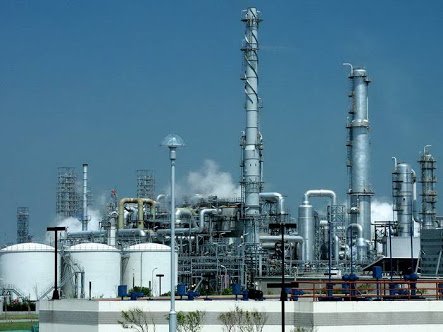
The method used in mining petroleum is the drilling method. In this method the underground rocks are sampled and tested for traces of oil. When the oil is discovered, a well is sunk to reach it with the aid of a drilling rig or derrick. The oil is then pumped out mechanically or naturally if the pressure within the oil zone in the soil is high.
**in the soil, three layers within the oil zone exist: **
- Natural gas is found on top
- petroleum or crude oil in the middle
- water at the bottom
Transportation and marketing
crude oil is transported mainly by pipe lines either to the refineries for refining or processing, or to the ports for export. Major markets include Britain, American, Japan, Germany and south Africa.
As petroleum and other fossil fuels are the major source of energy they are getting scarce And getting expensive my advice to the whole world is that we should look other sources to power up our cars and machineries.

Also most end product of fossil fuels cause depletion to the ozone layer.
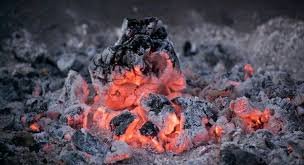

@resteemator is a new bot casting votes for its followers. Follow @resteemator and vote this comment to increase your chance to be voted in the future!